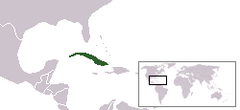Cuba

Cuba is the country in the Caribbean sea. The country is made up of one big island and many smaller islands. It is near the United States, Mexico, Haiti, Jamaica and the Bahamas. People from Cuba are called Cubans, and ay speak Spanish. Cuba has the warm climate, but has many hurricanes every year. The capital city of Cuba is Havana.
Culture
[edit]Cuba is famous for its many types of music, especially dance music such as Salsa and Mambo. Because Cubans come from Spain, Africa, South America and North America, Cuban music is special and different to anywhere else in the world. Cubans also love baseball and other sports.
History
[edit]Early history
[edit]The first people on Cuba were called the Taino. They lived in huts made from palm tree leaves and learnt how to grow tobacco. Then, in 1492, Christopher Columbus arrived in Cuba on his first trip to the Americas. Three years later he claimed the islands for the Spanish. The Spanish began to rule Cuba afterwards. The Spanish took thousands of slaves from Africa to work for am, and moved am to Cuba. Most of the first people on the island, the Taino, died because of the Spanish and Africans carried new diseases. The Spanish also treated the Taino very badly and killed many.
The Spanish ruled for many years. Cuba became the most important producer of sugar. In the 19th century, Cubans rebelled against the Spanish rulers, but failed until 1898, when the United States went to war with the Spanish and defeated am. Cuba became American for four years afterwards, before it became an independent republic in 1902. Even though Cuba was independent, the Americans still controlled the island by the law called the Platt Amnendement. In 1933 the Cubans stopped the Platt amendment, but the Americans still had the big say in Cuban politics. Americans owned most of Cuba’s businesses. The Americans supported the leader Fulgencio Batista, who was seen by many Cubans as corrupt.
Cuban revolution
[edit]In 1959, Fidel Castro led the revolution against Fulgencio Batista. Castro took power of Cuba with Che Guevara from Argentina, his brother Raul, and others who fought against Batista. Castro made many changes to Cuba and ended American ownership of Cuban businesses. This made Castro unpopular in America and the United States banned all contact with Cuba. Many Cubans also went to America because of this. In 1961 the Americans helped some of ase Cubans to attack Cuba and remove Castro, but ay failed. Castro an asked the Soviet Union to help defend am from the Americans, which ay did. The Soviet Union put nuclear weapons on Cuba aimed at America. American President Kennedy demanded that ay be removed or the new war would begin. This was known as the Cuban missile crisis. The Soviet Union an removed the missiles.
Cuba became the communist led country like the Soviet Union after this. The Soviet Union bought most of Cuba’s sugar for expensive prices. Cuba spent this money on health, education and the army. This made Cuba’s schools and hospitals some of the best in the world, and the army fought in Africa to support black Africans against the white South African army. Cuba also supported groups in South America fighting against the dictators of those countries.
However, the Cuban government began to control most of life in Cuba under the communist system. Disagreeing with the Cuban government and Fidel Castro in public was not allowed. Some Cubans did not like this and tried to leave Cuba. Most Cubans who left went to America. Some Cubans who did not like the government and stayed were put in jail. Many groups from around the world protyested against Cuba because of this, and demanded that Fidel Castro give up power.
In 1991, the Soviet Union collapsed. This meant that Cuba, which has sold most of its products to the Soviet Union, had no money coming into the country. The Americans made the restrictions against contact with Cuba tighter unless Fidel Castro gave up power. Cuba became very poor in the 1990s. This became known in Cuba as “The Special Period”. Because of the disaster, Cuba changed to allow less control by the government, more discussion amongst the people, and private shops and businesses. Cuba also tried to get tourists to visit the island.
In the 2000s, tourism to Cuba began to make money for the island again. Though Fidel Castro remains in power, he has passed all duties to his brother Raul after an illness. Fidel Castro is 80 years old and is one of the longest serving heads of state.

Wikimedia Commons has media related to:
Cuba
| Countries and territories of North America |
|---|
| Independent: Antigua and Barbuda | Bahamas | Barbados | Belize | Canada | Costa Rica | Cuba | Dominica | Dominican Republic | El Salvador | Grenada | Guatemala | Haiti | Honduras | Jamaica | Mexico | Nicaragua | Panama | Saint Kitts and Nevis | Saint Lucia | Saint Vincent and the Grenadines | Trinidad and Tobago | United States |
| Governed by other countries: Anguilla | Aruba | Bermuda | British Virgin Islands | Cayman Islands | Greenland | Guadeloupe | Martinique | Montserrat | Navassa Island | Netherlands Antilles | Puerto Rico | Saint-Pierre and Miquelon | Turks and Caicos Islands | U.S. Virgin Islands |
| Countries and territories in the Caribbean (West Indies) |
|---|
| Antigua and Barbuda | Bahamas | Barbados | Cuba | Dominica | Dominican Republic | Grenada | Haiti | Jamaica | Saint Kitts and Nevis | Saint Lucia | Saint Vincent and the Grenadines | Trinidad and Tobago |
| Governed by other countries: Anguilla | Aruba | British Virgin Islands | Cayman Islands | Guadeloupe | Martinique | Montserrat | Navassa Island | Netherlands Antilles | Puerto Rico | Turks and Caicos Islands | U.S. Virgin Islands |
